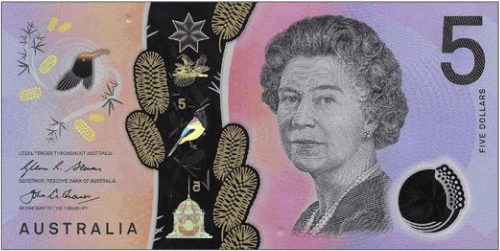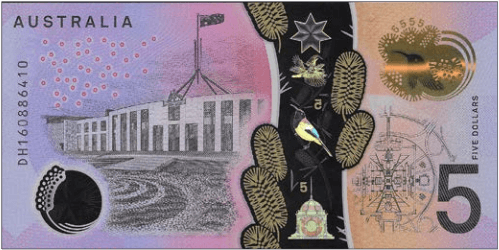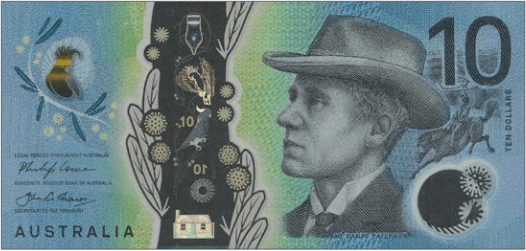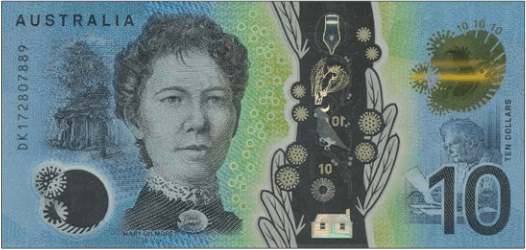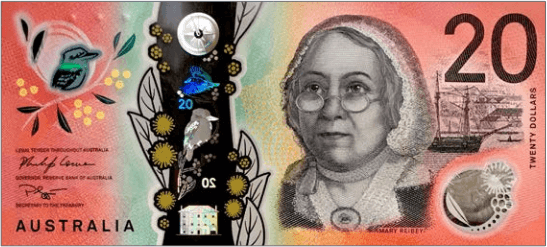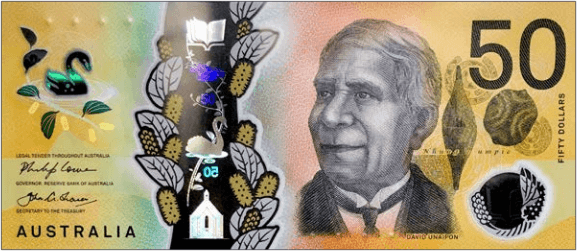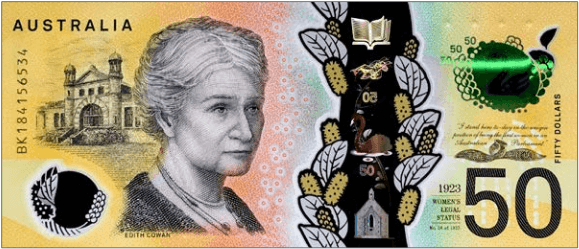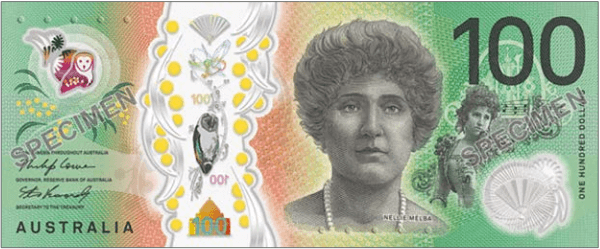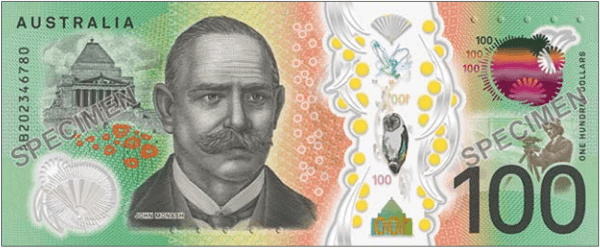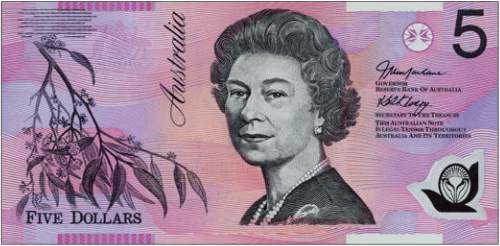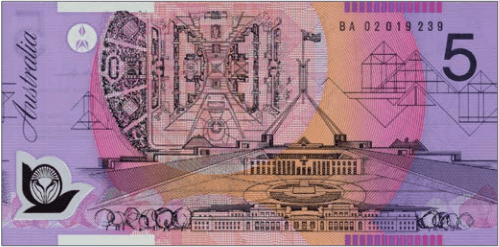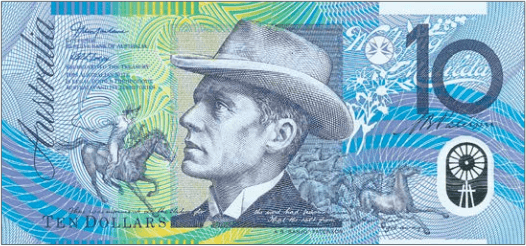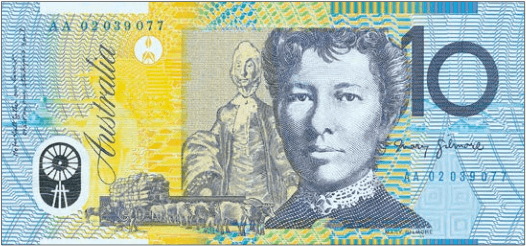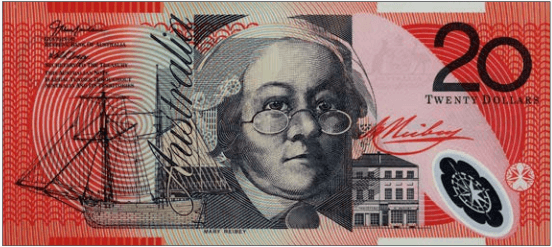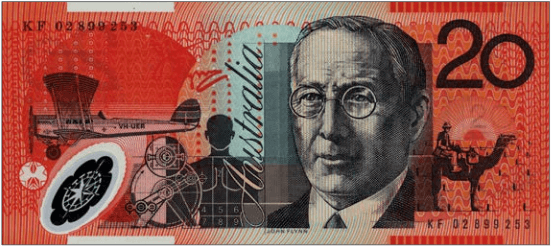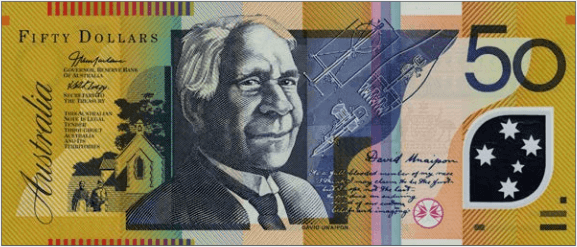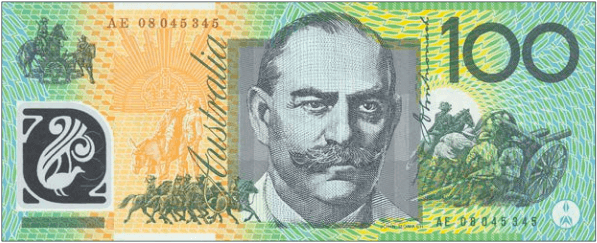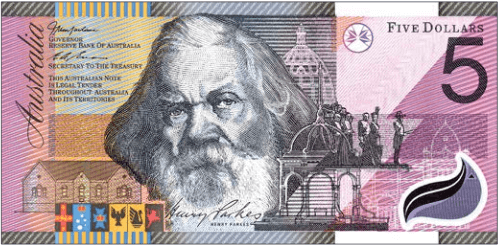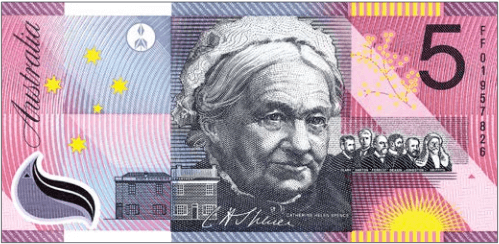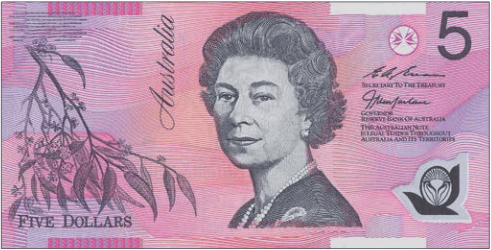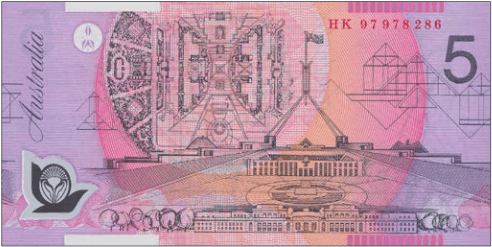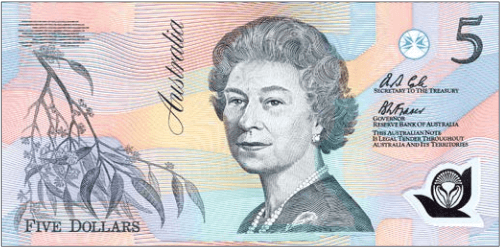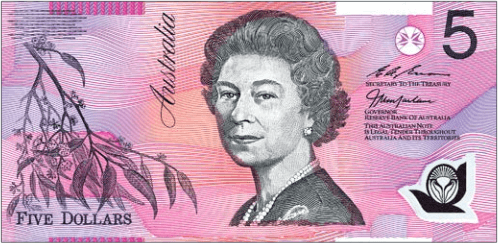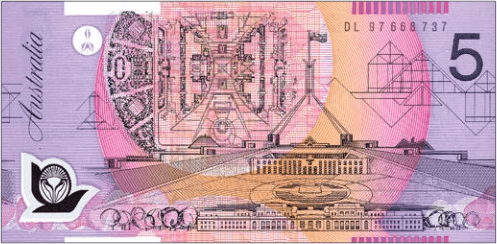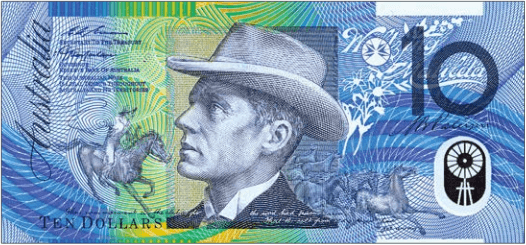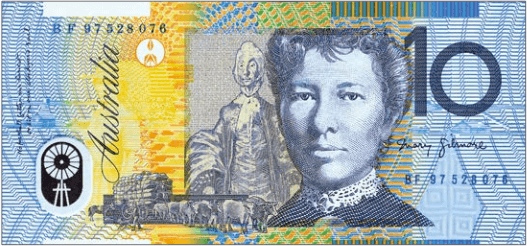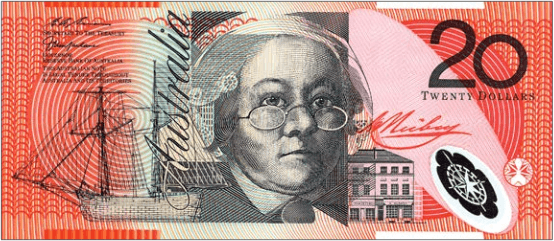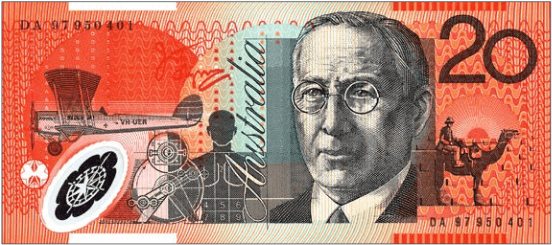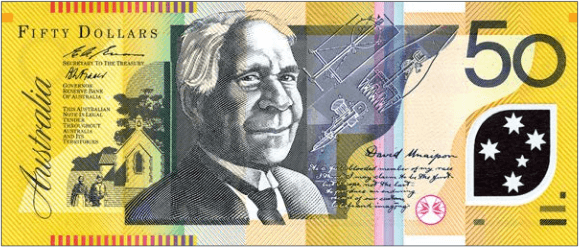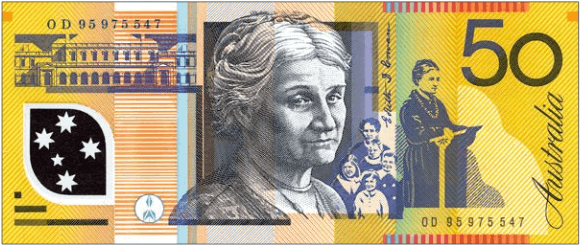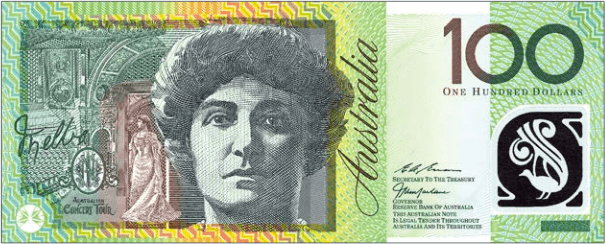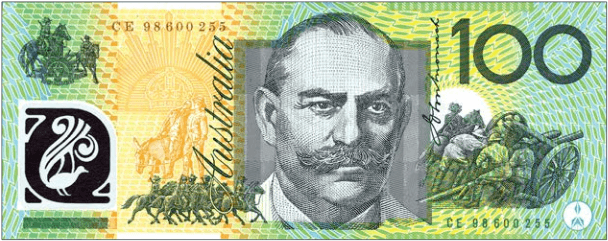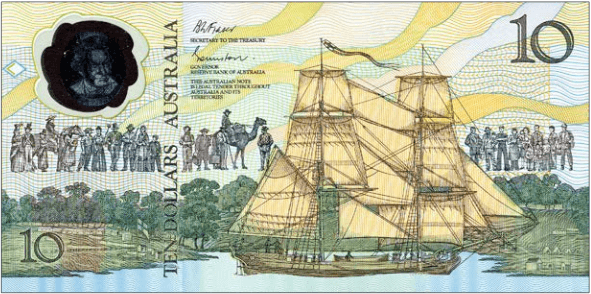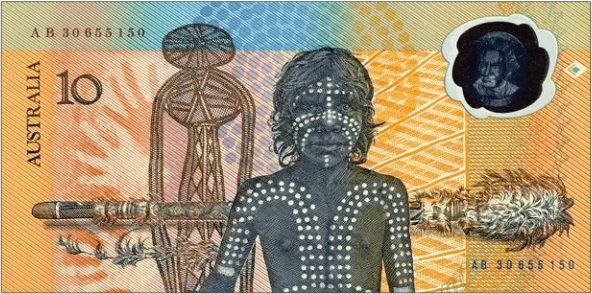AUD – Australian Dollar
Monetary System
1910: 1 Australian pound = 20 shillings
14.02.1966: 1 Australian dollar (AUD) = 100 cents
2016 – 2019 Issues
The 5-dollar note was the first in a new series like the preceding issues in color, size, and people portrayed, but with a new tactile feature to help the vision-impaired community distinguish between different denominations. Governor Glenn Stevens said, “Innovative new security features have been incorporated to help keep Australia’s banknotes secure from counterfeiting into the future… These include a distinctive top-to-bottom window. Each banknote in the new series will depict a different species of Australian wattle and a native bird within a number of the elements.”
Description: 5.00 AUD – Australian Dollar Size: 130 x 65 mm
Purple, orange, blue, green, red, and yellow. Front: English text; Prickly Moses wattle; Eastern Spinebill bird; Queen Elizabeth II. Back: English text; New Parliament House in Canberra; landscape plan for New Parliament House; Prickly Moses wattle; Eastern Spinebill bird. No security thread. Watermark (shadow image): None. Printer: (Note Printing Australia). 130 x 65 mm. Polymer (Guardian).
Description: 10.00 AUD – Australian Dollar Size: 137 x 65 mm
Blue, green, yellow, and orange. Front: English text; Bramble Wattle (Acacia victoriae); Sulphur-crested cockatoo (Cacatua galerita) bird on branch in SPARK; microprinting of lines from Paterson’s The Man From Snowy River; fountain pen nib; windmill; writer AB “Banjo” Paterson wearing hat; horseman holding whip and reigns. Back: English text; pen nib; woman and man standing outside rustic house in bushland; microprinting of lines from Paterson’s poem No Foe Shall Gather Our Harvest; Mary Gilmore from 1957 painting by William Dobell; Mary Gilmore with papers at desk. No security thread. Watermark (shadow image): None. Printer: (Note Printing Australia). 137 x 65 mm. Polymer (Guardian).
Description: 20.00 AUD – Australian Dollar Size: 144 x 65 mm
Red, orange, and green. Front: English text; Laughing Kookaburra (Dacelo novaeguineae); Acacia buxifolia wattle; Mary Reibey, businesswoman; Port Jackson schooner and traditional Eora nowie (canoe) in Sydney Cove in the early 1800s; compass. Back: English text; RFDS De Havilland aircraft leaving a remote Broken Hill homestead in 1948; compass; Reverend John Flynn; pedal-powered generator for wireless radio. No security thread. Watermark (shadow image): Coat of arms. Printer: (Note Printing Australia). 144 x 65 mm. Polymer (Guardian).
Description: 50.00 AUD – Australian Dollar Size: 151 x 65 mm
Yellow, red, orange, green, blue, and purple. Front: English text; Acacia humifusa; Black swan (Cygnus atratus) in SPARK; David Unaipon, inventor and author; ngaitji totems; Ngarrindjeri nation shields. Back: English text; King Edward Memorial Hospital; Edith Cowan, politician; gumnut brooch. No security thread. Watermark (shadow image): Coat of arms. Printer: (Note Printing Australia). 151 x 65 mm. Polymer (Guardian).
Description: 100.00 AUD – Australian Dollar Size: 158 x 65 mm
Green, orange, and yellow. Front: English text; Australian Masked Owl (Tyto novaehollandiae); Golden Wattle (Acacia pycnantha); Nellie Melba, soprano; Melba in costume as Rosina in Rossini’s Barber of Seville; monogram from the cover of Melba’s homecoming concert tour program of 1902. Back: English text; Shrine of Remembrance, Melbourne; John Monash, commander. No security thread. Watermark (shadow image): Coat of arms. Printer: (Note Printing Australia). 158 x 65 mm. Polymer (Guardian).
2002 – 2017 Issues
These notes are like the preceding issues, but the order of the signatures has been reversed and—except for Queen Elizabeth II on the five-dollar note—names have been added below the portraits for easier identification of the historical figures depicted.
Description: 5.00 AUD – Australian Dollar Size: 130 x 65 mm
Purple, orange, blue, green, red, and yellow. Front: English text; Scribbly gum eucalyptus leaves; Queen Elizabeth II; gum flower. Back: English text; gum flower; landscape plan for New Parliament House; Old and New Parliament Houses in Canberra; geometric patterns of architectural features of entrance to ministerial wing and skylights. No security thread. Watermark (shadow image): Coat of arms. Printer: (Note Printing Australia). 130 x 65 mm. Polymer (Guardian).
Description: 10.00 AUD – Australian Dollar Size: 137 x 65 mm
Blue, green, yellow, and orange. Front: English text; horseman holding whip and reigns; micro printing of lines from Paterson’s The Man From Snowy River; writer AB “Banjo” Paterson wearing hat; running horses (brumbies); Waltzing Matilda logo; windmill. Back: English text; windmill; bullock team carrying wool; micro printing of lines from Paterson’s poem No Foe Shall Gather Our Harvest; Mary Gilmore from 1957 painting by William Dobell; Mary Gilmore, socialist poet and journalist. No security thread. Watermark (shadow image): Coat of arms. Printer: (Note Printing Australia). 137 x 65 mm. Polymer (Guardian).
Description: 20.00 AUD – Australian Dollar Size: 144 x 65 mm
Red, orange, and green. Front: English text; 1806 schooner ship Mercury; Mary Reibey, businesswoman; Reibey’s shop building on George Street in Sydney; compass. Back: English text; air ambulance Victory biplane; compass; pedal-powered generator for wireless radio; “Where does it hurt?” medical diagram; Reverend John Flynn; Reverand Col Harland riding camel. No security thread. Watermark (shadow image): Coat of arms. Printer: (Note Printing Australia). 144 x 65 mm. Polymer (Guardian).
Description: 50.00 AUD – Australian Dollar Size: 151 x 65 mm
Yellow, red, orange, green, blue, and purple. Front: English text; mission church at Point McLeay; David Unaipon, inventor and author; Unaipon’s handwritten preface Legendary Tales of the Australian Aborigines; diagrams of mechanical handpiece for sheep shearing from Unaipon’s 1909 patent application; Southern Cross. Back: English text; Western Australian Parliament House; Southern Cross; Edith Cowan, politician; foster mother and wards; Cowan speaking at lectern. No security thread. Watermark (shadow image): Coat of arms. Printer: (Note Printing Australia). 151 x 65 mm. Polymer (Guardian).
Description: 100.00 AUD – Australian Dollar Size: 158 x 65 mm
Green, orange, and yellow. Front: English text; interior of Her Majesty’s Theatre in Sydney; Melba signature; monogram from 1902 Melba Australian Concert Tour program; Nellie Melba, soprano; lyrebird. Back: English text; World War I soldiers on horseback; lyrebird; Rising Sun badge; John Monash, commander; batteries of the 2nd Australian Division attacking the Hindenburg Line, from 1917 photograph Artillery in Noreuil Valley. No security thread. Watermark (shadow image): Coat of arms. Printer: (Note Printing Australia). 158 x 65 mm. Polymer (Guardian).
2001 Commemorative Issues
On 1 January, 2001, Australia celebrated 100 years of Federation under which the six self-governing colonies—New South Wales, Queensland, South Australia, Tasmania, Victoria, and Western Australia—combined to form the Commonwealth of Australia. As part of the celebrations, the Federation 5-dollar note was issued, circulating alongside the recolored 5-dollar note.
Description: 5.00 AUD – Australian Dollar Size: 130 X 65 mm
Purple, orange, blue, black, and yellow. Front: English text; Tenterfield School of Arts building; micro printing of Parkes’ Tenterfield Address; badges of New South Wales, Queensland, South Australia, Tasmania, Victoria, and Western Australia; politician and “Father of Federation,” Henry Parkes from 1892 painting by Tom Roberts; architectural drawings of Royal Exhibition Building in Melbourne, site of the first Commonwealth Parliament; Federation Pavilion in Sydney’s Centennial Park; The Duke of Cornwall and York (later to be King George V) opening Australia’s First Federal Parliament in 1901 from a painting by Tom Roberts. Back: English text; stars of Southern Cross; South Australian Children’s Department building in Adelaide; Catherine Helen Spence, journalist and social reformer; microprinting of Parkes’ Advance Australia Fair; Andrew Inglis Clark (Tasmania), Edmund Barton (New South Wales), John Forrest (Western Australia), Alfred Deakin (Victoria), Charles Kingston (South Australia) and Samuel Griffith (Queensland); spray of wattle; sunrise. No security thread. Watermark (shadow image): None. Printer: (Note Printing Australia). 130 x 65 mm. Polymer (Guardian).
Designed by Garry Emery.
1996 – 1997 Numismatic Products
This 5-dollar note was issued to commemorate the return of Hong Kong to China on 1 July 1997. The cost of the note in a folder was A$18, and an 8-piece uncut sheet cost A$180.
Description: 5.00 AUD – Australian Dollar Size: 130 X 65 mm
1992 – 1999 Issues
This series does not include 1- or 2-dollar notes because those denominations were replaced by coins on 14 May 1984 and 20 June 1988, respectively. The color of the 5-dollar note was brightened in 1995 to assist in distinguishing it from the 10-dollar note. At the same time, the font for the 5 in the upper right corners on front and back was changed to match that of the other denominations, and orientation bars were added to assist in the automated sorting of the notes.
Starting in 1993, the first two digits of the serial number represent the last two digits of the year. Over the years, the Reserve Bank of Australia has sold various collectors packs with serial numbers under 10,000. In some cases, notes with particular dates are available only in these sets and as such are not listed as issued varieties because they were not intended to circulate.
There are many other numismatic products containing notes with overprints of FIRST ISSUED, date in various colors, and various different colored serial numbers.
Description: 5.00 AUD – Australian Dollar Size: 130 X 65 mm
Purple, orange, blue, green, red, and yellow. Front: English text; Scribbly gum eucalyptus leaves; Queen Elizabeth II wearing Queen Victoria’s Golden Jubilee necklace and Queen Alexandra’s cluster earrings, from photograph by John Lawrence; gum flower. Back: English text; gum flower; landscape plan for New Parliament House; Old and New Parliament Houses in Canberra; geometric patterns of architectural features of entrance to ministerial wing and skylights. No security thread. Watermark (shadow image): Coat of arms. Printer: (Note Printing Australia). 130 x 65 mm. Polymer (Guardian).
Designed by Bruce Stewart.These notes have been observed with s/n in different shades of green. For dated 5-dollar notes with orientation bars at left on front and right on back.
Description: 5.00 AUD – Australian Dollar Size: 130 X 65 mm
Purple, orange, blue, green, red, and yellow. Front: English text; Scribbly gum eucalyptus leaves; Queen Elizabeth II wearing Queen Victoria’s Golden Jubilee necklace and Queen Alexandra’s cluster earrings, from photograph by John Lawrence; gum flower. Back: English text; gum flower; landscape plan for New Parliament House; Old and New Parliament Houses in Canberra; geometric patterns of architectural features of entrance to ministerial wing and skylights. No security thread. Watermark (shadow image): Coat of arms. Printer: (Note Printing Australia). 130 x 65 mm. Polymer (Guardian).
Description: 10.00 AUD – Australian Dollar Size: 137 x 65 mm
Blue, green, yellow, and orange. Front: English text; horseman holding whip and reigns; microprinting of lines from Paterson’s The Man From Snowy River; writer AB “Banjo” Paterson wearing hat; running horses (brumbies); Waltzing Matilda logo; windmill. Back: English text; windmill; bullock team carrying wool; microprinting of lines from Paterson’s poem No Foe Shall Gather Our Harvest; Mary Gilmore from 1957 painting by William Dobell; Mary Gilmore, socialist poet and journalist. No security thread. Watermark (shadow image): Coat of arms. Printer: (Note Printing Australia). 137 x 65 mm. Polymer (Guardian).
Designed by Max Robinson. During the printing of the 10-dollar notes, the ink was changed to prevent wet ink transfer between sheets. This also resulted in a subtle color shift from blue to gray.
Description: 20.00 AUD – Australian Dollar Size: 144 x 65 mm
Red, orange, and green. Front: English text; 1806 schooner ship Mercury; Mary Reibey, businesswoman; Reibey’s shopbuilding on George Street in Sydney; compass. Back: English text; air ambulance Victory biplane; compass; pedal-powered generator for wireless radio; “Where does it hurt?” medical diagram; Reverend John Flynn; Reverend Col Harland riding camel. No security thread. Watermark (shadow image): Coat of arms. Printer: (Note Printing Australia). 144 x 65 mm. Polymer (Guardian).
Designed by Garry Emery.
Description: 50.00 AUD – Australian Dollar Size: 151 x 65 mm
Yellow, red, orange, green, blue, and purple. Front: English text; mission church at Point McLeay; David Unaipon, inventor and author; Unaipon’s handwritten preface Legendary Tales of the Australian Aborigines; diagrams of mechanical handpiece for sheep shearing from Unaipon’s 1909 patent application; Southern Cross. Back: English text; Western Australian Parliament House; Southern Cross; Edith Cowan, politician; foster mother and wards; Cowan speaking at lectern. No security thread. Watermark (shadow image): Coat of arms. Printer: (Note Printing Australia). 151 x 65 mm. Polymer (Guardian).
Designed by Brian Sadgrove.
Description: 100.00 AUD – Australian Dollar Size: 158 x 65 mm
Green, orange, and yellow. Front: English text; interior of Her Majesty’s Theatre in Sydney; Melba signature; monogram from 1902 Melba Australian Concert Tour program; Nellie Melba, soprano; lyrebird. Back: English text; World War I soldiers on horseback; lyrebird; Rising Sun badge; John Monash, commander; batteries of the 2nd Australian Division attacking the Hindenburg Line, from 1917 photograph Artillery in Noreuil Valley. No security thread. Watermark (shadow image): Coat of arms. Printer: (Note Printing Australia). 158 x 65 mm. Polymer (Guardian).
Designed by Bruce Stewart.
1988 Commemorative Issues
This 10-dollar commemorative note is the first polymer issue of Australia. Shortly after introduction, it was withdrawn because the optical variable device (OVD) on the see-through window could be easily rubbed off. A revised variety was issued a few months later with the OVD covered with a thin plastic film. Notes with the faulty OVD can be identified by serial numbers XX XX 93X XXX, XX XX 95X XXX, and XX XX 96X XXX.
Description: 10.00 AUD – Australian Dollar Size: 155 x 77.5 mm
Green, orange, yellow, blue, and purple. Front: English text; OVD of Captain Cook; Queue of Australians (early colonial officer and wife, convict woman, surveyor, village woman, gold digger, pioneer woman, bushranger, urban woman, urban child, shearer, Chinese worker, kanaka [island worker], camel driver, Boer War soldier, aviatrix, depression swaggy, World War II sailor, World War II female factory worker, migrant family, Asian female worker and construction worker); HMS Supply sailing ship in Sydney Cove. Back: English text; ancient stencils of hands and rock painting of woman; Morning Star Pole; aboriginal boy wearing body paint. No security thread. Watermark: None. Printer: (Note Printing Australia). 155 x 77.5 mm. Polymer (Guardian).
Designed by Harry Williamson. It is the first note in the world to include an OVD, and Australia’s first to be printed on polymer substrate.
Commonwealth of Australia
When the six separate British self-governing colonies of New South Wales, Queensland, South Australia, Tasmania, Victoria, and Western Australia agreed to unite and form the Commonwealth of Australia (COA) on 1 January 1901, the Australian parliament assumed power to make laws with respect to banking and currency, and was keen to have a nationally-acceptable currency. The passing of the Australian Notes Act of 1910, which assigned responsibility for the issue of banknotes to the Commonwealth treasury, made it an offense for any bank to circulate banknotes issued by a state and withdrew their status as legal tender. Further, the issuing of banknotes by private banks was effectively discouraged by the Bank Notes Tax Act, also of 1910, which imposed a tax of 10 per cent per annum on all banknotes still circulating.
In 1911, the first Commonwealth Bank Act gave the Commonwealth Bank of Australia only the ordinary functions of commercial and savings banking; the bank did not specifically have a central banking remit and it was not responsible for the note issue. Management of the bank was vested in the governor. The bank opened for business in mid-1912. At that time, the note issue was administered by the Australian Department of the Treasury, which had taken it over from the private trading banks and the Queensland government.
In 1920, responsibility for the note issue was transferred from the treasury to a Notes Board (consisting of four members, appointed by the government). The governor of the bank was ex officio a member of the Notes Board. The administration of the note issue was undertaken by the bank, though the bank and the Notes Board were formally independent of each other.
In 1924, the Commonwealth Bank Act was amended and the Commonwealth Bank of Australia was given control over the note issue. The Reserve Bank Act 1959 preserved the original corporate body, under the new name of the Reserve Bank of Australia, to carry on the central banking functions of the Commonwealth Bank, which had evolved over time; other legislation separated the commercial banking and savings banking activities into the newly created Commonwealth Banking Corporation.
Reserve Bank of Australia
The Reserve Bank Act 1959 created the Reserve Bank of Australia (RBA) to carry on the central banking functions of the Commonwealth Bank of Australia; at that same time, the commercial and savings banking functions were transferred into a new institution, the Commonwealth Banking Corporation. The Reserve Bank Act 1959 took effect from 14 January 1960. For more information, visit www.rba.gov.au.

